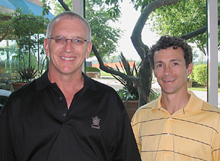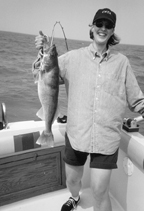It's all in the family for Archipelago. The ECN turned stock exchange for
Nasdaq and listed trading has much of Wall Street watching closely as it goes public. That's because the metamorphosis of Archipelago Holdings is the result of its close connections to its customers, investment bankers, competitors and a regulator.
Many of these parties hold a stake in the company, which operates Archipelago Exchange (ArcaEx). Some have bought a stake. Others have earned it through large-scale executions. Now the stakeholders are betting that these relationships will be profitable. And that Archipelago can survive with the other two big boys of the trading industry, Instinet and Nasdaq.
Archipelago Holdings officials, who declined comment on the story because of IPO rules, hope that more than strong volume and their pure play matching engine will keep the company in the black. Some trading executives question whether this will work at a time when many players are practically giving away their services to obtain vital liquidity pools.
Fighting Competition
In an offering that Archipelago hopes will raise up to $150 million, the company is asking investors to bet on its continued growth, profits, a diversification of its trading model and that the company can fight off dog-eat-dog competition.
The random element in these battles is the Securities and Exchange Commission's proposed Reg NMS. Both Archipelago and its big rivals, the NYSE and Nasdaq, are hoping the process will result in a more favorable market structure. But they all can't be winners in this sweepstakes.
So Archipelago, which last year executed 104.3 billion Nasdaq shares as well as relatively small amounts of NYSE and Amex listed business, is about to go public. Many of the biggest trading firms, several of them with a share in the one-time ECN, will be monitoring these events. A number of them, including Goldman Sachs, CS First Boston and Merrill Lynch, will serve as investment bankers in the deal. Indeed, officials of many trading firms and investment bankers, who normally speak to Traders Magazine, declined comment because of potential conflicts of interest. Another official, Archipelago CEO Gerald Putnam, understandably can't comment. He has a 3.02 percent stake in the company.
Does Archipelago, with its Pacific Exchange/ArcaEx facility that is also a regulator, have the right formula to survive in a very competitive trading and regulatory environment?
The Archipelago IPO prospectus, which notes that the company was in the black in the first quarter after years of red ink, outlines some rocky and hopeful scenarios for this would be public company.
"Our status as a facility of PCX Equities allows us to generate revenues from two additional sources, market data fees and listing fees, which we were ineligible to earn as an ECN," according to the 328-page registration statement. Proceeds of the offering would be used for the expansion and diversification of product offerings.
Archipelago, which began in 1996 as one of the original four SEC "qualified" ECNs, was created in the wake of the order handling rules. The company expects that its greatest expansion will come at the expense of the Big Board and Nasdaq.
But that could be a difficult proposition. If the plan goes as projected, it would mean that Archipelago will have to succeed in an area in which it has so far failed, according to some industry observers.
Archipelago's growth in Nasdaq business in the last three years has been dramatic – from just under six percent market share in 2001 to just over 25.5 percent in the first quarter of this year. However, the unsuccessful part of the business has been on the pure listed side. It has made almost no impact on the New York Stock Exchange.
Listing Trading
Archipelago's share of Big Board listed business was less than one percent back in 2001. Today, it is only 1.6 percent. ArcaEx has frequently highlighted its much larger share of trading in ETFs. But listed trading overall is weak, even though there has been some isolated success in a handful of single listed stock names. "The NYSE has significantly more liquidity in trading securities listed on its exchange than we do," Archipelago said in the offering.
"This means that market participants send more orders for purchase or sale of NYSE-listed securities to the NYSE than ArcaEx. It is easier for sellers to find buyers, and for buyers to find sellers, in a large group of buyers and sellers than in a small group (i.e., a more liquid market). Market participants are also more likely to get the best price for their orders when their orders are exposed to the largest number of buyers and sellers."
Of course, there is a concerted effort by electronic trading players, including Archipelago, Instinet and Nasdaq, to further open up the doors for them to listed stock trading. That could follow if the SEC takes their side in some of the proposals in Reg NMS. Archipelago concedes that the current trade-through rule could curb its ambition to expand in listed trading. Therefore, uncertainty rules at least until the SEC decides on the Reg NMS proposals.
In the meantime, Archipelago officials, in their IPO document, acknowledge the risk of a model that has been in the red through most of its history.
Another part of Archipelago's vulnerability is that it now garners almost all of its income from transaction-based business. That means diversified competitors are better equipped to survive sour markets in which transaction volume levels decline. Indeed, between 2000 and 2002, Archipelago lost between $35 million and $39 million each year.
"Some of our competitors," according to Archipelago, "derive their revenues from more than one source as a result of a more diversified product and service offerings. For example, Nasdaq realizes substantial revenue from listing fees. As a result, lower transaction fees or market data fees may impact our operating results and future profitability more significantly than our competitors, providing them with a competitive advantage in pricing their products and services or withstanding a reduction in trading volume."
Institutional Flow
At the same time, Nasdaq is also trying to block one of Archipelago's most important potential resources – institutional order flow.
Archipelago, through ArcaEx, has in the past tried to undercut Nasdaq by sponsoring institutional order flow from buyside desks through its Wave Securities, the brokerage headed by former SEC official Joseph Lombard. Nasdaq recently tried to counter that Archipelago strategy by purchasing the BRUT ECN, which as a registered broker dealer can sponsor similar order flow. The BRUT acquisition will "augment Nasdaq's existing position by deepening Nasdaq's liquidity pool," Robert Greifeld, president and CEO of Nasdaq, said when the purchase was announced.
BRUT is a unique ECN. It has positioned itself as a business that would not pursue institutions directly. Instead, it takes a back door by working with sellside clients. So BRUT, unlike INET and ArcaEx, has never intended to disintermediate the sellside.
With the acquisition of BRUT, Nasdaq appears to be loaded for bear. Greifeld has also said that he expects the BRUT acquisition will pay more dividends after regulators are finished implementing various market structure plans now under review. Recently, he was quoted as saying that these changes will help market centers to access each other through a broker dealer.
Legal Exchange
The BRUT purchase certainly changes the nature of Nasdaq, a business in the midst of trying to transform itself into a legal exchange. Buying this upstart competitor will pay off, Nasdaq officials claim. That's because this would-be exchange now will be able to tap new pools of liquidity, including other exchanges and Electronic Communication Networks, Nasdaq officials say.
Still, the move also has its downside. Nasdaq, in buying BRUT, bought a broker dealer/ECN that competes against many of its customers. But Nasdaq/BRUT, if it emulates the ArcaEx/Archipelago corporate structure, should still be able to canvass and sponsor institutional order flow. Nasdaq could split BRUT in two parts – one for institutional and the other part for the smart routing business. That's what one trading official told Traders Magazine.
"They [Nasdaq] really need a routing business because, if Nasdaq wanted to route to INET, they would require a broker dealer to accomplish that because only broker dealers can subscribe to INET," he said. He added that, because of the precedents set by ArcaEx, Nasdaq could do that. But whether it will actually do that or not will be based on business needs, he added. "What would Goldman say if a Nasdaq affiliate started talking to their clients?" the official asked.
Meanwhile, Archipelago, in going public, is also trying to convince the investors that it has figured out the trading world.
Archipelago's gamble is also on a model that depends on matching orders for profits, while competitors don't see matching as a big profit center, according to one trading industry official well acquainted with the company.
"Archipelago is really the only player matching on a pure play basis. I think of Nasdaq, for example, as a matching engine business that needs to be good enough to keep people there. Hence the BRUT transaction. But the difference is that Nasdaq isn't looking to make money doing it. They're looking to make money listing companies," the executive says.
The executive added that, just as Nasdaq expected to make money from its new brokerage affiliation, so Instinet is going to derive profits from its brokerage connection. Unless Archipelago, this executive says, finds a "way to hang some business on the matching engine, I think they're in for a struggle."
Several trading executives, who also couldn't be quoted by name because their firms had some connection to the IPO, praised Archipelago. "It's a great matching system, highly-technologically advanced," says one trader. "But it's a little hard to grow your way to profitability when the product is free," he quipped.
Still, an executive of an electronic firm had a different take on Archipelago's competitive position, saying he likes its long-term prospects.
"Nasdaq's buyout of BRUT is unlikely to have much of an effect on the Arca business," according to John "Wally" Sullivan, a co-founder and CEO of Pulse Trading. "Pricing is so low now that clients' focus will shift to product quality and service – two areas in which Arca has done very well."
However, the other question facing Archipelago is: Will it have trouble keeping up with competitors who have broader revenues and a better model?
Besides the lack of diversification and the battle for buyside order flow, another potential problem for Archipelago is a brutal marketplace. Intense competition forces effective players to discount aggressively and rebate in order to maintain or expand market share. That's even though that may cause some or all of these players to lose money. This has been one of the factors that put Archipelago in the red in the past few years.
In April 2002, Archipelago had to cut transaction fees. Archipelago was caught in a vicious cycle. The discounts and rebates meant "our revenues per transaction executed on the Archipelago system declined and the growth of our transaction fees was significantly lower than the growth of our trading volumes over the period," according to Archipelago.
"For example, in 2002 our transaction fees increased by 107 percent although our trading volume increased by over 170 percent in the same period. Similarly, in 2003 our transaction fees increased by 20.5 percent although our trading volumes increased by over 40 percent in the same period."
Another potential problem for Archipelago is Nasdaq's new pricing schedule changes for its SuperMontage platform, announced in April. These changes were designed to attract high volume customers, customers that could be taken away from Archipelago.
Healthy Competition
But Pulse's Sullivan says Archipelago will be able to cope. "With their quality product and service, Archipelago should continue to be a significant player in the OTC trading landscape," he said. And Sullivan also argued that Archipelago, unlike many other electronic competitors that were swallowed, should survive. "In my opinion, a competitive electronic market structure needs at least three healthy participants so we are currently at the minimum level," Sullivan says. He added that a strong Archipelago is critical for competitive markets.
Archipelago concedes in the IPO prospectus that ECNs and alternative trading systems could ultimately undercut efforts to stay profitable. But Archipelago now faces a huge ECN called SuperMontage.
"We rely on high volume market participants for a significant portion of our trading volumes and revenues," according to Archipelago. "If Nasdaq's new pricing schedule succeeds in encouraging high-volume participants to shift trading activity from ArcaEx to Nasdaq, our trading volumes and our revenues will be materially and adversely affected."
Access Fees
One example was cited in the IPO document. Nasdaq no longer charges clients for "taking liquidity." This could hurt Archipelago's attempt to expand its weak listed business. That's because Archipelago currently charges customers a penny for taking liquidity from ArcaEx in NYSE securities. The pending Reg NMS process could also be problematic for Archipelago. The SEC is proposing to cap access fees at a penny.
"If the proposal is ultimately adopted in this form," Archipelago warns investors, "we believe that the amount of transaction fees we earn, which represents over 99 percent of total revenues, would potentially decrease by a material amount. Our analysis assumes, however, that trading activity and market share would remain constant and does not give effect to changes investors may make in their trading patterns as a result of or in response to the proposed regulation. Under the proposed rule, we would be potentially unable to increase our revenues through higher pricing of transaction fees in the future, which would have a material adverse effect on our revenues and operating results."
Archipelago's customers could be considered unusual. They are often its investors. That's because between 2001 and 2003, investors each year indirectly generated about 40 percent of Archipelago's annual revenues.
Another challenge for Archipelago, if it is to be consistently in the black, is its listing fee business. This is an area in which Nasdaq and the NYSE are dominant and in which Archipelago has so far lagged. It has been deriving less than one percent of its revenues directly from this line.
"Almost all of our listing revenue is derived from dual listed NYSE-issuers that selected the Pacific Exchange as an additional listing venue prior to our launch of ArcaEx. Only two issuers have listed their equity securities on the Pacific Exchange following our launch of ArcaEx, and both listings resulted in little or no trading activity," according to Archipelago.
One trading industry official added that Archipelago's efforts to obtain listing business will likely be successful. His reasoning is that, in an era of greater shareholder demands, there is going to more pressure for multiple or dual listings.
At the same time, the launch of Archipelago's AraEx has put the company in a position to gain new advantages. The company now gains data fees that it couldn't when it was an ECN and it no longer incurs clearing charges for transactions matched internally. As an ECN, it was paying clearing charges, the IPO noted. And Archipelago also pointed to what was a big turnaround in the first quarter. That's when the company earned some $22 million on total revenues of $146.7 million, a huge turnaround from the previous quarter when it lost about $20 million.
The Improvement
Why was Archipelago finally in the black? The company listed three factors: 1) Increased volume; 2) The migration of trading in Nasdaq securities from Archipelago ECN to the Archipelago system, and 3) An increase in the number of orders that were matched internally.
Archipelago's fortunes appear to be strongly tied to its continued internalization, strong volume and the prosperity of its clients and investors. That is why this public company will be the ultimate bet on the trading industry. As big trading firms fortunes go, so will go Archipelago's.
Principal Shareholders in Archipelago Holdings
From the beginning of 2000 until June 30, 2001, Archipelago instituted an equity entitlement program that meant that many of its customers and competitors have become major shareholders. Participating customers became eligible to "earn equity entitlements" based on "the volume or order flow on our trading platforms," according to Archipelago. The brokerage Terra Nova Trading was among the participants in the program.
Here are some of the shareholders in Archipelago.
Goldman Sachs 23.86%
GAP Archa Holdings 23.38%
Credit Suisse First Boston 7.78%
Fidelity Global Brokerage 6.76%
Merrill Lynch 5.01%
Instinet International 4.39%
Pacific Exchange,
which is one of Archipelago's regulators 4.12%
J.P. Morgan Chase & Co., 3.68%
GSP, LLC, 3.02%
Virgo Enterprises 3.02%
Charles Schwab & Co., 2.84%
TD Waterhouse Group 2.29%
E*Trade Financial Corp. 2.08%
National Discount Brokers Group 1.01%
American Century Ventures 1.00%
Gerald Putnam 3.02%
Stuart Townsend 3.02%
MarrGwen Townsend 3.02%
(The last three are directors and executive officers of the company). Archipelago Affiliates Archipelago CEO Gerald Putnam owns 40 percent of Terra Nova Trading (TNT), a broker dealer that has a 0.6 percent stake in Archipelago. MarrGwen and Stuart Townsend also have a 40 percent stake in Terra Nova. All are executives of Archipelago. Archipelago has received transaction fees from Terra Nova and has made liquidity payments to Terra Nova as well as rebate payments. "We believe that all payments to TNT, and all amounts charged to TNT, are determined based on prevailing market rates, terms and conditions, which are available to all other market participants," according to Archipelago. Other affiliated party relationships include Wave Securities, a broker dealer owned by Archipelago. ASB, LLC, a service bureau located in Chicago, which provides backoffice services to Wave Securities. These services include clearing technology and routing technology to alternative trading venues, reporting to the NASD's Order Audit Trial System. Wave Securities has been paying ASB $100,000 a month for these services since December 2002, according to the Archipelago IPO prospectus. Townsend and Putnam are both 40 percent owners of ASB. Finally, for five years through March 2004, Archipelago rented a yacht for business development functions. It has cost the company about $500,000 a year. The "domestic partner of Mr. Putnam's sister" has operated the yacht, according to the IPO document. Archipelago will not be continuing the yacht rental, the document said. Archipelago officials, citing quiet period IPO rules, were not able to comment on any of the document or the future of the company. At presstime, they also said that they were not sure when the IPO would take place.



















